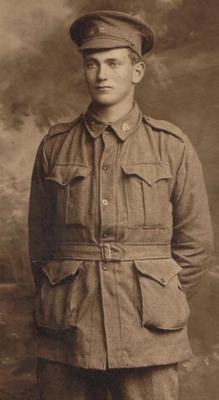
A century on from the end of World War I we acknowledge their service …
Lest we forget.
Private Cyril William Loveday
Born: 29 April 1896 Batesford, Victoria. Died: 1 September 1966 Essendon.
Enlisted: 30 July 1917 aged 21.
Served: Western Front.
Cyril was born at Batesford near Geelong, the second of William and Elizabeth Loveday’s 11 children. The family settled on a property at Pakenham South called “Beryl Bark”, next to the Ellett farm, around 1910. Before the War, Cyril, his father and brothers cut chaff around Geelong and surrounding areas. They used a chaff cutter with a steam engine, which Cyril operated as he obtained his steam engine driver’s licence when he was just 12.
Sadly, one of Cyril’s brothers, Lyle drowned in the September 1916 floods which broke through the levies on the McDonald’s, McGregor’s and Seven Mile drains, flooding a wide area of Pakenham South and Dalmore. After this, the family moved to Rossiter Road Kooweerup in 1917 and apparently went into partnership with a member of the Bould family cutting hay locally, including for Mr Lecky of Officer.
Cyril was a 21 year old engine driver when he enlisted for service on 3 July 1917. Interestingly, his army service file is stamped “Sports 1000”, which signifies that he enlisted as part of the special “Sportsmen’s Thousand” recruitment drive. The objective was to effectively raise a battalion of young, fit Australian sportsmen to reinforce the seriously depleted AIF on the Western Front. From Cyril’s war service records, he certainly appears to have been athletic, standing 1.8m tall, weighing 171 pounds (77.5kgs) and with a chest measuring 95 cms (10). Cyril played football and was even into motor cycle racing.
Cyril arrived in Europe in January 1918 and was trained in the use of the Lewis machine gun, but contracted first influenza, then measles. He was taken on strength with the 8th Battalion in France in May, during the Germans’ “Spring Offensive” and just after Australian forces had halted the rapid German advance on Amiens at Villers-Bretonneux. Over the coming months, the Allies gradually gained the upper hand in the fighting. Although Cyril never spoke much about his wartime experiences, he did recount that on one occasion, a bullet hit him, but fortunately bounced off the cigarette case in the top left hand pocket of his tunic. Cyril later gave the damaged case to a WWII soldier, hoping it would bring him good luck too.
In early August 1918, the Allies launched their own offensive near Amiens, which spectacularly broke through the German positions in places The Germans resorted to extensive chemical warfare, firing thousands of “yellow cross” (mustard gas) shells into the shattered woods and valleys. The toll from the gas was severe, with many men’s eyes were affected while others received burns. The soldiers’ clothes were soaked in gas, and men dozing with their respirators on fell ill. Some 90 men had to be evacuated, among them Cyril. He was evacuated to a casualty clearing station suffering from pain in the chest, blindness and aphonia (inability to produce voiced sound). For Cyril, the War was effectively over.
After the War, Cyril worked as a labourer at Kooweerup, including a period with State Rivers and Water Supply Commission. In 1925, he married Elvine Mary (“Queenie”) Mortensen and subsequently had two children. By the early 1940s, the family had moved to Caulfield West, where Cyril was working as an engineer. The family later lived in St Kilda East and Moonee Ponds.
In the 1940s, Cyril was working variously as an engine driver, excavator operator, and as a boiler attendant at Royal Melbourne Hospital . During WWII, he and his brother Ivan both served with the Civil Construction Corps.
This is an extract from Patrick Ferry’s book A Century After The Guns Fell Silent – Remembering the Pakenham District’s WWI Diggers 1914-18.
For more details on this and other profiles in the book, head to the website www.pakenhamww1.com







